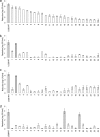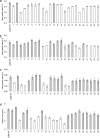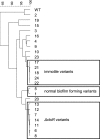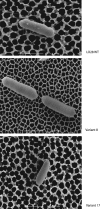Population diversity of Listeria monocytogenes LO28: phenotypic and genotypic characterization of variants resistant to high hydrostatic pressure
- PMID: 20139309
- PMCID: PMC2849257
- DOI: 10.1128/AEM.02434-09
Population diversity of Listeria monocytogenes LO28: phenotypic and genotypic characterization of variants resistant to high hydrostatic pressure
Abstract
A comparative phenotype analysis of 24 Listeria monocytogenes LO28 stress-resistant variants obtained after high-pressure treatment was performed to assess their robustness and growth performance under a range of food-relevant conditions. In addition, genetic analysis was conducted to characterize the promoter regions and open reading frames of the class I and III transcriptional repressors CtsR and HrcA, which control production of specific sets of stress proteins. Analysis of stress survival capacity, motility, biofilm formation, and growth under various conditions showed all variants to be more resistant to pressure and heat than the wild type; however, differences among variants were observed in acid resistance, growth rate, motility, and biofilm-forming capacity. Genetic analysis revealed no variation in the genetic make-up of hrcA and its upstream region, but two variants had deletions in the upstream region of ctsR and seven variants had mutations in the ctsR gene itself. The results of the characterization were cluster analyzed to obtain insight into the diversity of variants. Ten unique variants and three clusters with specific features could be identified: one cluster consisting of seven variants having a mutation in the CtsR regulator gene, one cluster containing two variants with an aerobic biofilm formation capacity similar to that of the wild type, and a cluster composed of five immotile variants. The large population diversity of L. monocytogenes stress-resistant variants signifies the organism's genetic flexibility, which in turn may contribute to the survival and persistence of this human pathogen in food-processing environments.
Figures







References
-
- Cheftel, J. C. 1995. Review: high-pressure, microbial inactivation and food preservation. Food Sci. Technol. Int. 1:75-90.
-
- Chen, H. 2007. Use of linear, Weibull, and log-logistic functions to model pressure inactivation of seven foodborne pathogens in milk. Food Microbiol. 24:197-204. - PubMed
-
- Chen, H., H. Neetoo, M. Ye, and R. D. Joerger. 2009. Differences in pressure tolerance of Listeria monocytogenes strains are not correlated with other stress tolerances and are not based on differences in CtsR. Food Microbiol. 26:404-408. - PubMed
-
- Considine, K. M., A. L. Kelly, G. F. Fitzgerald, C. Hill, and R. D. Sleator. 2008. High-pressure processing: effects on microbial food safety and food quality. FEMS Microbiol. Lett. 281:1-9. - PubMed
MeSH terms
Substances
LinkOut - more resources
Full Text Sources

